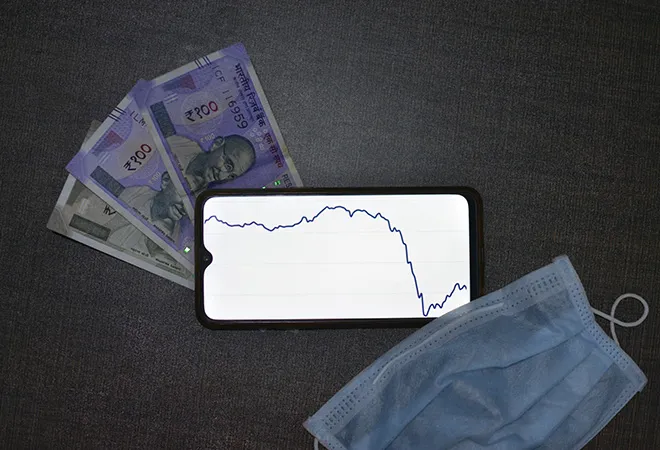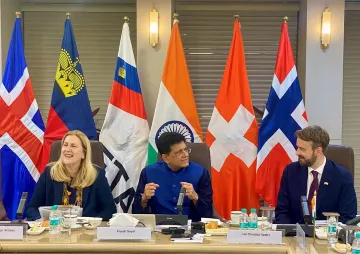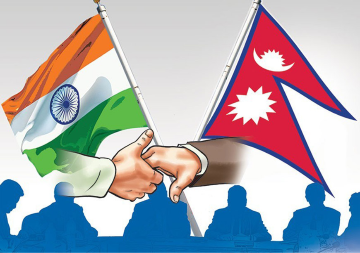
India is the fifth-largest economy in the world, with GDP of $2.94 trillion in 2019 (IMF’s World Economic Outlook). The US, China, Japan and Germany are larger economies than India. It is already the third largest, behind China and the US, when economic size is measured in purchasing power parity (PPP) dollars. In 1980, India’s per-capita GDP of USD 354 was marginally above China’s USD 339. Currently the Chinese per-capita GDP is over USD 10,000 while India is just above USD 2200. GDP growth rates in China over the past 30 years have averaged 10% annually; this is sufficient evidence that populous economies can also sustain continuous high growth.
China has grown leaps and bounds over the past 40 years. It is a global manufacturing hub and the world’s largest exporter and second-largest importer. It’s not surprising that post-Covid and the various worries around Chinese products, the global supply chains might be redrawn to reduce any political and steady-supply risks. This could be an opportunity for India to look inward, to induce domestic manufacturing capability, as well as promote export orientation of its industries.
It’s not surprising that post-Covid and the various worries around Chinese products, the global supply chains might be redrawn to reduce any political and steady-supply risks. This could be an opportunity for India to look inward
India has only seven companies in the Fortune Global 500 list while China has 119 companies. The Indian enterprises surely need to catch up. We do have a huge opportunity for economic enhancement by leveraging our inherent young demographics, a domestic consumption market eager for newer products and services, and a fairly-productive agrarian sector which can only further improve with focused efficiency building.
Our Prime Minister had set a GDP target
of USD 5 trillion economy in the next five years. To meet this challenge, we have to be globally competitive and would need growth of 15% per annum. While it is a tall order in the current Covid-19 hit economic situation, we can use the opportunity to reset the way we function.
We need to create a “mission” and ensure that we drive down the message to every citizen to participate with their full might for this nation-building activity. This assumes that there would be speedy progress in policy development for building world-class infrastructure, developing positive business ecosystem that can drive up investor confidence, revamped education and skilling initiatives, and better quality healthcare system and cities infrastructure. These in turn, also improve the nation’s livability index as well as the Human Development Index positioning.
Collaboration - the efficient way
This socio-economic growth objective would require cohesive public-private partnership. Government should demonstrate policy stability and signal that its open to policy innovations. The government can invest in building infrastructure. By signaling its investments, it can boost global investor confidence. It should quickly bring in developmental policies that would attract investments and capital from around the world. This would also boost the domestic economy and employment levels. The private sector can bring in newer business models, along with investments, to make high quality products / services, that can find takers globally.
However, to enable this, we would need to use the leverage concept with strong and consistent domestic lending, to push strong domestic demand. This can help encourage import-substitution and export-promotion strategies.
Financing to growth and digital as financial inclusion tool
Timely investments and committed businesses will spur growth. A stronger financial market (debt markets especially) and the push to raise the standards of corporate governance would give confidence to the investors. The manufacturing sector would benefit from proactive labor law reforms and from enhanced skilling initiatives.
Timely investments and committed businesses will spur growth. A stronger financial market (debt markets especially) and the push to raise the standards of corporate governance would give confidence to the investors
Financing India’s growth objective will need multiple initiatives. The total size of the Indian banking industry is about Rs 100 lakh crore (
USD 1.3 trillion). Economists and bankers agree that with our blend of services sector being a dominant GDP player, we would need to double the current credit pool (banking sector size) to help achieve the USD 5 trillion economy. In the past, our banking sector has had high credit growth.
A look at comparative figures for China & the US:
Chinese banking system was USD 40.6 trillion, in 2019 with the GDP at USD 15 trillion.
The US’s banking system was at USD 18 trillion and helped build GDP of USD 21 trillion.
An important sector where we will need capital investment is the infrastructure sector. This sector would need financial leverage as well. India does not have infrastructure financing institutions with large balance sheets. In this context, we must remember the efforts of the public sector banks (PSBs) as they have traditionally funded real-economy sectors. It is essential that the government continues to hold stake in 2-3 well capitalised large PSBs, as their contribution to lending to infra sectors will prevail. The government’s estimates that it would make Rs 100 lakh crore infrastructure investments over the next five years is any indicator, it could set the tone for positive investment sentiment. This could increase flow of money in the system, improved employment rates, and increased cash flows for corporate India and consequent boost to the capital & debt markets.
The digital wave that’s all around us will play a critical role in enabling and improving access to financial products and services throughout India. With digital, information cannot be an arbitrage between geographies or economic might of the customers.
The digital wave that’s all around us will play a critical role in enabling and improving access to financial products and services throughout India. With digital, information cannot be an arbitrage between geographies or economic might of the customers.
We can further enable partnerships between various financial services firms and the new-age digital financial institutions to enable consumer acquisition and having consumer feedback in real time to design suitable financial products for different consumer needs. Digital finance will also improve financial literacy and help expand the financing backbone into smaller markets across the country.
A lot of policy initiatives like IBC, decriminalising archaic low-impact rules, work on improving the ease-of-doing business, especially in the financial sector will add to positive sentiment and also enhance financial stability. For this “Mission GDP growth”, we need to work at a war footing, for stable yet rapid growth of the finance sector and to work on policy initiatives to deepen our debt / bond / capital markets, and to reduce regulatory arbitrage across banks and non-banks.
Building on positive momentum
In this Covid-19 gloom, there are early signs of smaller economic revival. Data for May & June for economic activity indicators such as fuel consumption, electricity usage, volume and value of retail financial transactions, movement of goods across the country, e-way bills, highway toll collections indicate growth in activities. Manufacturing PMI rose to 47.2 from a low of 27.4 in April.
CMIE unemployment number for June is about 11% from 23.5% in May. With a good monsoon, it would lead to rural demand for products and services, including higher spends in housing and consumer durables. If the monsoon and the coming festival season can be utilised with adequate positive policy communication over next three months, it could increase domestic investments and consumption.
This reset time should be used to push the Indian manufacturing sector to increase domestic production as “import-substitution” mission. Of course, we just use this for selective products and not lose out on cheaper products that we can import and those where we can never achieve those economies of scale. It is the right time for India to create newer consumer base with differentiated products and services, at affordable pricing.
For all these, timely availability of finance will be crucial. The government should create a “mission 5 x 5” (USD 5 trillion in 5 years) for the Indian financial services sector and encourage the institutions to have their contribution to nation’s growth as a mission. We need to offer confidence to entrepreneurs - micro, small, medium, large sized businesses - that the ease of doing of business will be amongst the best in the world; and to give confidence to bankers to lend. We need to lend our way to growth, it is the biggest driver of growth.
The views expressed above belong to the author(s). ORF research and analyses now available on Telegram! Click here to access our curated content — blogs, longforms and interviews.



 India is the fifth-largest economy in the world, with GDP of $2.94 trillion in 2019 (IMF’s World Economic Outlook). The US, China, Japan and Germany are larger economies than India. It is already the third largest, behind China and the US, when economic size is measured in purchasing power parity (PPP) dollars. In 1980, India’s per-capita GDP of USD 354 was marginally above China’s USD 339. Currently the Chinese per-capita GDP is over USD 10,000 while India is just above USD 2200. GDP growth rates in China over the past 30 years have averaged 10% annually; this is sufficient evidence that populous economies can also sustain continuous high growth.
China has grown leaps and bounds over the past 40 years. It is a global manufacturing hub and the world’s largest exporter and second-largest importer. It’s not surprising that post-Covid and the various worries around Chinese products, the global supply chains might be redrawn to reduce any political and steady-supply risks. This could be an opportunity for India to look inward, to induce domestic manufacturing capability, as well as promote export orientation of its industries.
India is the fifth-largest economy in the world, with GDP of $2.94 trillion in 2019 (IMF’s World Economic Outlook). The US, China, Japan and Germany are larger economies than India. It is already the third largest, behind China and the US, when economic size is measured in purchasing power parity (PPP) dollars. In 1980, India’s per-capita GDP of USD 354 was marginally above China’s USD 339. Currently the Chinese per-capita GDP is over USD 10,000 while India is just above USD 2200. GDP growth rates in China over the past 30 years have averaged 10% annually; this is sufficient evidence that populous economies can also sustain continuous high growth.
China has grown leaps and bounds over the past 40 years. It is a global manufacturing hub and the world’s largest exporter and second-largest importer. It’s not surprising that post-Covid and the various worries around Chinese products, the global supply chains might be redrawn to reduce any political and steady-supply risks. This could be an opportunity for India to look inward, to induce domestic manufacturing capability, as well as promote export orientation of its industries.
 PREV
PREV

